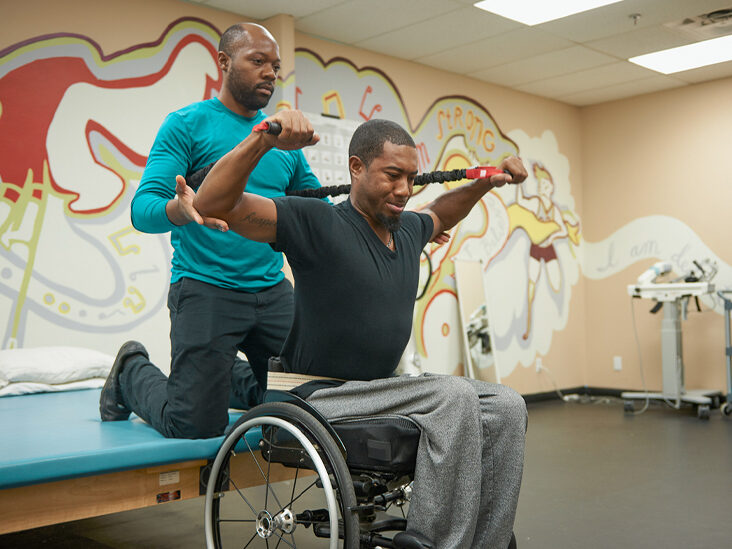Multiple sclerosis (MS) is a debilitating disease that can cause a wide range of symptoms, including physical, emotional, and cognitive problems. MS is an autoimmune disorder that affects the central nervous system. There is no known cure for MS, but there are treatments available that can help lessen the symptoms. One such treatment is physical therapy. Physical therapy is effective in reducing pain, improving mobility, and enhancing the quality of life for people with MS.
Contents
- 1 What Is Multiple Sclerosis?
- 2 Does physical therapy help with multiple sclerosis?
- 3 What Types Of Physical Therapy Is Used In Multiple sclerosis?
- 4 How Physical Therapy Help With Multiple sclerosis
- 5 How Often Should You See a Physical Therapist?
- 6 What should Physical therapists with multiple sclerosis avoid?
- 7 Conclusion
What Is Multiple Sclerosis?

Multiple sclerosis (MS) is a chronic, progressive neurological disease that attacks the central nervous system (CNS), which includes the brain, spinal cord, and optic nerves. The disease disrupts communication between the brain and other parts of the body, leading to a wide range of symptoms including muscle weakness, paralysis, problems with balance and coordination, vision problems, and chronic pain.
While there is no cure for MS, there are treatments available that can help manage the symptoms and slow the progression of the disease. One of the most effective treatments for MS is physical therapy.
Does physical therapy help with multiple sclerosis?
Yes, physical therapy can help with multiple sclerosis. The goal of physical therapy is to help people with MS stay as independent and mobile as possible. This therapy can help improve strength, balance, and coordination. It can also help with fatigue and pain.
There is no one-size-fits-all approach to physical therapy for MS. A physical therapist
There is no one-size-fits-all answer to this question, as the effect of physical therapy on multiple sclerosis (MS) symptoms can vary greatly from person to person. However, many people with MS do find that physical therapy can help to improve their quality of life by alleviating some of the symptoms associated with the condition.
What Types Of Physical Therapy Is Used In Multiple sclerosis?

There are different types of Physical therapy is multiple sclerosis. They are as follows:
Aerobic Exercise
It helps to improve the function of your heart and lungs and also increases the production of endorphins, which can help to improve your mood. For example, walking, jogging, swimming, and biking.
Balance and Coordination Training
It helps to improve your balance and coordination. It helps to increase the range of motion of your joints and also improves your balance. For example, tai chi and yoga.
Yoga: It is a form of exercise that includes different postures and breathing techniques. It can help to improve your flexibility, strength, and balance. Additionally, yoga can help to reduce stress and improve your overall sense of well-being.
Tai Chi: Tai chi is a slow, gentle form of martial arts. It can help with balance, coordination, and flexibility. It helps in multiple sclerosis physical therapy.
Pilates: Pilates is a form of exercise that focuses on strengthening the core muscles. It can help to improve your posture, flexibility, and balance. Additionally, pilates can help to reduce stress and improve your overall sense of well-being.
Functional Training: Functional training helps you learn how to use your muscles more effectively. It can improve your balance, coordination, and strength. Additionally, functional training can help to reduce the risk of injuries.
Cardiovascular Training
It helps to build up your heart and lungs. For example, walking, running, biking, or swimming. For people with MS, this can help to:
- Reduce fatigue
- Improve stamina
- Lower your risk of heart disease
Progressive Strength Training
Progressive strength training is a type of exercise that slowly increases the amount of weight and resistance as the muscles get stronger. This type of training can help improve muscle strength, endurance, and quality of life in people with MS.For example, a 2016 study found that people with MS who did progressive strength training for 16 weeks had significant improvements in muscle strength, fatigue, and quality of life compared to those who didn’t do the training.
Muscle Strength Training
Muscle strength training is one of the most important aspects of physical therapy for multiple sclerosis. By strengthening the muscles, patients can help to improve their overall mobility and function. In addition, regular muscle strength training can help to prevent future injuries by reducing the risk of falls and other accidents.
Massage
It helps to relax your muscles and reduce stress. You can get a professional massage or use a massager at home. For people who have multiple sclerosis, physical therapy can be a great way to manage symptoms and improve their quality of life. The Swedish massage technique is the most common and gentle type of massage. It uses long, smooth strokes to help you relax.
Exercise
It is important to exercise helps to improve your overall fitness and well-being. It also helps to reduce fatigue and improve your sleep quality. For instance, you can do some simple exercises at home or go for a walk in the park. Your physiotherapist can design an exercise program that is right for you.
Acupuncture
Acupuncture is a form of traditional Chinese medicine that involves inserting thin needles into specific points on the body. It is sometimes used as a treatment for various conditions, including pain and fatigue.
Biofeedback
Biofeedback is a treatment that uses different techniques to help you control your body’s functions. For instance, it can help you control your heart rate or blood pressure. Biofeedback can be used to treat conditions such as pain, anxiety, and stress.
Heat or Cold Therapy
It helps to relieve pain and muscle spasms. For instance, you can alternate between hot and cold packs, or apply heat before exercising to loosen your muscles. It helps in multiple sclerosis physical therapy by providing pain relief.
Transcutaneous Electrical Nerve Stimulation (TENS)
It is a form of electrical nerve stimulation that is commonly used to relieve pain. The electrical current helps to block the pain signal from reaching the brain. It helps in the release of endorphins, which are natural painkillers produced by the body.
These are just a few types of physical therapy treatments that can be beneficial for people with multiple sclerosis. If you are interested in trying any of these treatments, be sure to talk to your doctor or a physical therapist first.
How Physical Therapy Help With Multiple sclerosis
Physical therapy can help people with multiple sclerosis in several ways. For example, It can:
Reduce pain and spasticity: Spasticity is a common symptom of MS, and it can be quite painful. PT can help to reduce the pain and stiffness associated with spasticity.
Increase mobility: People with MS may have difficulty moving around due to muscle weakness or loss of balance. PT can help to improve your mobility and range of motion.
Improve fatigue: Fatigue is a common symptom of MS, and it can be very debilitating. Physical therapy can help to reduce fatigue and improve your overall energy levels.
Improve balance: People with MS often have difficulty maintaining their balance. PT can help to improve your balance and prevent falls.
Help with fatigue management: People with MS often experience fatigue, which can be very debilitating. Physical therapy can help to reduce fatigue and improve your overall energy levels.
Build strength and endurance: MS can lead to muscle weakness and loss of endurance. PT can help to build up your strength and stamina.
Improve balance: People with MS often have difficulty maintaining their balance. PT can help to improve your balance and prevent falls.
These are just a few of the ways that physical therapy can help people with MS.
Physical therapy is important for people with MS because it can help them to manage the symptoms of the disease. PT can also help people with MS to prevent further decline and to improve their overall function.
How Often Should You See a Physical Therapist?
The frequency of physical therapy for people multiple sclerosis with varies depending on the individual. Some people may need to see a PT once or twice a week, while others may only need to see a PT once or twice a month. It is important to talk to your doctor or physical therapist about how often you should be seeing a Physical therapist.
What should Physical therapists with multiple sclerosis avoid?
There are various things that physical therapists should avoid when treating patients with multiple sclerosis. They are as follows:
- First and foremost, they should avoid anything that could potentially trigger multiple sclerosis flare-ups. This includes anything that might cause the patient to overheat, as heat can be a trigger for MS flares. They should also avoid any sudden or jarring movements, as these can also trigger flares.
- In addition, physical therapists should avoid anything that could potentially worsen the patient’s condition. This includes any exercises or activities that are too strenuous, as they could make the patient’s symptoms worse. They should also avoid any treatments that are known to be ineffective for MS.
- Finally, physical therapists should avoid anything that could cause the patient discomfort or pain. This includes any treatments that are known to be painful, as well as any exercises or activities that may be too difficult for the patient.
Conclusion
It may be concluded that multiple sclerosis physical therapy is an effective treatment for patients with multiple sclerosis. The therapy can improve the patient’s quality of life and help them cope with the disease.
Physical Therapy help patients recover from pain. If you’re experiencing Back pain, Shoulder pain, Knee pain, Neck pain, Elbow pain, Hip pain, or Arthritis pain, a physical therapist at MantraCare can help: Book a physiotherapy session.


